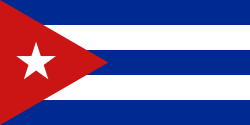Granma (provins)

For andre betydninger, se Granma
| Provinsen Granma | |||
|---|---|---|---|
| |||
(c) R01k, CC BY 3.0 Gade i Bayamo | |||
| Overblik | |||
| Land: | |||
| Administrativt center: | Bayamo | ||
| Demografi | |||
| Indbyggere: | 835.675 (2010)[1] | ||
| - Areal: | 8.377 km² | ||
| - Befolkningstæthed: | 99,8 pr. km² | ||
| Andet | |||
| Tidszone: | UTC-05:00 | ||
| Hjemmeside: | www.granma.inf.cu | ||
| Oversigtskort | |||
 | |||
Provinsen Granma er en af Cubas provinser. Den er lokaliseret i den sydlige del af Cuba. Hovedstaden hedder Bayamo og af andre større byer kan nævnes: Manzanillo og Pilón.
Historie
Provinsen har navn efter båden Granma, som Fidel Castro, Che Guevara og 82 andre guerillaer i 1956, brugte til at rejse fra Mexico til Cuba og indlede den cubanske revolution.
Administrativ opdeling
Provinsen er opdelt i 13 kommuner:
| Kommune | Indbyggertal (2004) | Areal (km²) |
|---|---|---|
| Bartolomé Masó | 53.024 | 629 |
| Bayamo | 222.118 | 918 |
| Buey Arriba | 31.327 | 452 |
| Campechuela | 46.092 | 577 |
| Cauto Cristo | 21.159 | 550 |
| Guisa | 50.923 | 596 |
| Jiguaní | 60.320 | 646 |
| Manzanillo | 130.789 | 498 |
| Media Luna | 35.330 | 376 |
| Niquero | 41.252 | 582 |
| Pilón | 29.751 | 462 |
| Río Cauto | 47.833 | 1.500 |
| Yara | 59.415 | 576 |
Referencer
- ^ www.one.cu (fra Wikidata).
Eksterne henvisninger
| Spire |
Medier brugt på denne side
Forfatter/Opretter: TUBS
Location of province xy (see filename) in Cuba.
the 2 flags most likely represent the Cespedes flag. the flag used for Cuba during the ten years war. The bell on side of the shield most likely represents the slaves that Carlos Manuel de Cespedes freed from his plantation. The diagonal stripes on the left side of the shield most likely symbolize the department division of the island under Spanish colonialism, which also is part of the Cuban flag.The top side of the shield most likely represents the mountainous part of Granma. The right side of the shield represents the Granma yacht, used by Fidel Castro. The wheat grains most likely represent the economic branch of agriculture which makes up 39% of the land. Lastly the star or mullet most likely represents an independent state which is Cuba, also the same meaning that is in the star of the Cuban flag. [1]






